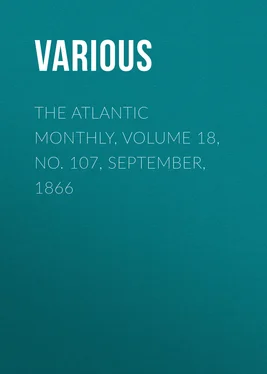Various - The Atlantic Monthly, Volume 18, No. 107, September, 1866
Здесь есть возможность читать онлайн «Various - The Atlantic Monthly, Volume 18, No. 107, September, 1866» — ознакомительный отрывок электронной книги совершенно бесплатно, а после прочтения отрывка купить полную версию. В некоторых случаях можно слушать аудио, скачать через торрент в формате fb2 и присутствует краткое содержание. Жанр: foreign_antique, periodic, foreign_edu, на английском языке. Описание произведения, (предисловие) а так же отзывы посетителей доступны на портале библиотеки ЛибКат.
- Название:The Atlantic Monthly, Volume 18, No. 107, September, 1866
- Автор:
- Жанр:
- Год:неизвестен
- ISBN:нет данных
- Рейтинг книги:4 / 5. Голосов: 1
-
Избранное:Добавить в избранное
- Отзывы:
-
Ваша оценка:
- 80
- 1
- 2
- 3
- 4
- 5
The Atlantic Monthly, Volume 18, No. 107, September, 1866: краткое содержание, описание и аннотация
Предлагаем к чтению аннотацию, описание, краткое содержание или предисловие (зависит от того, что написал сам автор книги «The Atlantic Monthly, Volume 18, No. 107, September, 1866»). Если вы не нашли необходимую информацию о книге — напишите в комментариях, мы постараемся отыскать её.
The Atlantic Monthly, Volume 18, No. 107, September, 1866 — читать онлайн ознакомительный отрывок
Ниже представлен текст книги, разбитый по страницам. Система сохранения места последней прочитанной страницы, позволяет с удобством читать онлайн бесплатно книгу «The Atlantic Monthly, Volume 18, No. 107, September, 1866», без необходимости каждый раз заново искать на чём Вы остановились. Поставьте закладку, и сможете в любой момент перейти на страницу, на которой закончили чтение.
Интервал:
Закладка:
Although the Knight of the Tower disapproved of young ladies being taught to write, there were women whose employment writing seems to have been; but these were nuns safely shut up from the risk of billets-doux . In Dr. Maitland's Essays on the Dark Ages, he quotes from the biography of Diemudis, a devout nun of the eleventh century, a list of the volumes which she prepared with her own hand, written in beautiful and legible characters, to the praise of God, and of the holy Apostles Peter and Paul, the patrons of the monastery, which was that of Wessobrunn in Bavaria. The list comprises thirty-one works, many of them in three or four volumes; and although Diemudis is not supposed to have been an authoress, she is certainly worthy of having her name handed down through eight centuries in witness of woman's indefatigable work in the scriptorium. One missal prepared by Diemudis was given to the Bishop of Treves, another to the Bishop of Augsburg, and one Bible in two volumes is mentioned, which was exchanged by the monastery for an estate.
We can picture to ourselves Diemudis in her conventual dress, seated in the scriptorium, with her materials for chirography. The sun, as it streams through the window, throws a golden light over the vellum page, suggesting the rich hue of the gilded nimbus, while in the convent garden she sees the white lily or the modest violet, which, typical of the Madonna, she transfers to her illuminated borders. Thus has God ever interwoven truth and love with their correspondences of beauty and development in the natural world, which were open to the eyes of Diemudis eight hundred years ago, perhaps as clearly as to our own in these latter days. That women of even an earlier century than that of Diemudis were permitted to read, if not to write, is proved by the description of a private library, given in the letters of C. S. Sidonius Apollinaris, and quoted in Edwards's "History of Libraries." This book-collection was the property of a gentleman of the fifth century, residing at his castle of Prusiana. It was divided into three departments, the first of which was expressly intended for the ladies of the family, and contained books of piety and devotion. The second department was for men, and is rather ungallantly stated to have been of a higher order; yet, as the third department was intended for the whole family, and contained such works as Augustine, Origen, Varro, Prudentius, and Horace, the literary tastes of the ladies should have been satisfied. We are also told that it was the custom at the castle of Prusiana to discuss at dinner the books read in the morning,—which would tend to a belief that conversation at the dinner-tables of the fifth century might be quite as edifying as at those of the nineteenth.
A few feminine names connected with the literature of the Middle Ages have come down to us. The lays of Marie de France are among the manuscripts in the British Museum. Marie's personal history, as well as the period when she flourished, is uncertain. Her style is extremely obscure; but in her Preface she seems aware of this defect, yet defends it by the example of the ancients. She considers it the duty of all persons to employ their talents; and as her gifts were intellectual, she cast her thoughts in various directions ere she determined upon her peculiar mission. She had intended translating from the Latin a good history, but some one else unluckily anticipated her; and she finally settled herself down to poetry, and to the translation of numerous lays she had treasured in her memory, as these would be new to many of her readers. Like other literary ladies, she complains of envy and persecution, but she perseveres through all difficulties, and dedicates her book "to the King."
Marie was born in France. Some authorities suppose she wrote in England during the reign of Henry III., and that the patron she names was William Langue-espée, who died in 1226; others, that this plus vaillant patron was William, Count of Flanders, who accompanied St. Louis on his first crusade in 1248, and was killed at a tournament in 1251. A later surmise is that the book was dedicated to Stephen, French being his native language. Among the manuscripts of the Bibliothèque Royale at Paris, is Marie's translation of the fables which Henry Beauclerc translated from Latin into English, and which Marie renders into French. A proof that Marie's poems are extremely ancient is deduced from the names in one of these fables applied to the wolf and the fox. She uses other names than those of Ysengrin and Renard, which were introduced as early as the reign of Cœur de Lion, and it would seem that she could not have failed to notice these remarkable names, had they existed in her time. A complete collection of the works of Marie de France was published in Paris in 1820, by M. de Roquefort, who speaks of her in the following terms: "She possessed that penetration which distinguishes at first sight the different passions of mankind, which seizes upon the different forms they assume, and, remarking the objects of their notice, discovers at the same time the means by which they are attained." If this be a true statement, the acuteness of feminine observation has gained but little in the progress of the centuries, and her literary sisters of the present era can hardly hope to eclipse the penetration of Marie de France.
The Countesses de Die, supposed to be mother and daughter, were both poetesses. The elder lady was beloved by Rabaud d'Orange, who died in 1173, and the younger is celebrated by William Adhémar, a distinguished troubadour. He was visited on his death-bed by both these ladies, who afterwards erected a monument to his memory. The younger countess retired to a convent, and died soon after Adhémar.
In the Harleian Collection is a fine manuscript containing the writings of Christine de Pisan, a distinguished woman of the fourteenth century. Her father, Thomas de Pisan, a celebrated savant of Bologna, had married a daughter of a member of the Grand Council of Venice. So renowned was Thomas de Pisan that the kings of Hungary and France determined to win him away from Bologna. Charles V. of France, surnamed the Wise, was successful, and Thomas de Pisan went to Paris in 1368; his transfer to the French court making a great sensation among learned and scientific circles of that day. Charles loaded him with wealth and honors, and chose him Astrologer Royal. According to the history, as told by Louisa Stuart Costello, in her "Specimens of the Early Poetry of France," Christine was but five years old when she accompanied her parents to Paris, where she received every advantage of education, and, inheriting her father's literary tastes, early became learned in languages and science. Her personal charms, together with her father's high favor at court, attracted many admirers. She married Stephen Castel, a young gentleman of Picardy, to whom she was tenderly attached, and whose character she has drawn in most favorable colors. A few years passed happily, but, alas! changes came. The king died, the pension and offices bestowed upon Thomas de Pisan were suspended, and the Astrologer Royal soon followed his patron beyond the stars. Castel was also deprived of his preferments; and though he maintained his wife and family for a time, he was cut off by death at thirty-four years of age.
Christine had need of all her energies to meet such a succession of calamities, following close on so brilliant a career. Devoting herself anew to study, she determined to improve her talents for composition, and to make her literary attainments a means of support for her children. The illustrations in the manuscript volume of her works picture to us several scenes in Christine's life. In one, the artist has sliced off the side of a house to allow us to see Christine in her study, giving us also the exterior, roof, and dormer-windows, with points finished by gilt balls. The room is very small, with a crimson and white tapestry hanging. Christine wears what may be called the regulation color for literary ladies,—blue, with the extraordinary two-peaked head-dress of the period, put on in a decidedly strong-minded manner. At her feet sits a white dog, small, but wise-looking, with a collar of gold bells round his neck. Before Christine stands a plain table, covered with green cloth; her book, bound in crimson and gold, in which she is writing, lies before her.
Читать дальшеИнтервал:
Закладка:
Похожие книги на «The Atlantic Monthly, Volume 18, No. 107, September, 1866»
Представляем Вашему вниманию похожие книги на «The Atlantic Monthly, Volume 18, No. 107, September, 1866» списком для выбора. Мы отобрали схожую по названию и смыслу литературу в надежде предоставить читателям больше вариантов отыскать новые, интересные, ещё непрочитанные произведения.
Обсуждение, отзывы о книге «The Atlantic Monthly, Volume 18, No. 107, September, 1866» и просто собственные мнения читателей. Оставьте ваши комментарии, напишите, что Вы думаете о произведении, его смысле или главных героях. Укажите что конкретно понравилось, а что нет, и почему Вы так считаете.












